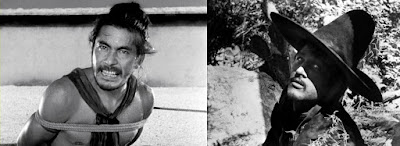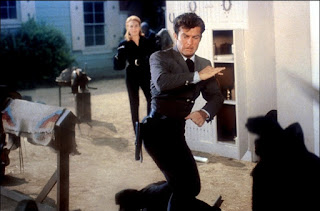by Troy D. Smith
If you've been watching the AMC western about the transcontinental railroad,
Hell on Wheels (which is ending its five-year run next week), you know that for the past couple of seasons the Chinese workers have been a heavy focus. Only fans of the Western Fictioneers novel series
Wolf Creek would notice that many of the subplots, such as the Chinese criminal kingpin Chang and his importing "hatchet-men" from San Francisco, appeared in that series first. Both series, though, are part of a long tradition of bringing the East to Westerns.
That tradition started in a big way in the 1960s and flourished in the 1970s. Before that, the only time you saw Asians in westerns was as servants, most notably the caricature Hop Sing as the family cook on Bonanza (1959-1963). Also notable was Paladin's unfortunately named hotel clerk Hey Boy in
Have Gun Will Travel (1957-1963). That show, which featured writing by Gene Roddenberry and was generally more progressive than many westerns, also featured a character named Hey Girl. It did occasionally go beyond the stereotypes and show some elements of the Chinese characters' culture.
But the real East-West conduit was the Japanese director Akira Kurasawa.
Chanbara, or sword-fighting films, became extremely popular in Japan after WWII and into the 1970s (oddly enough, also the golden age of the Hollywood western). Kurasawa's
chanbara became popular in Europe and the U.S. as well, in part because his style -heavily influenced by American director John Ford -translated well to western audiences. Several of his movies -which often starred Toshiro Mifune -were re-interpreted as westerns:
The Seven Samurai (1954) became
The Magnificent Seven (1960);
Yojimbo (1961) became
A Fistful of Dollars (1964); and, less successfully,
Rashomon (1950) became
The Outrage (1964) -which probably flopped due to the very questionable casting of Paul Newman as a Mexican bandit (!)
Kurasawa's
chanbara and westerns had a circular relationship. The samurai movies appealed to American audiences because they felt like westerns; they felt like westerns because Kurasawa was influenced by John Ford; Kurasawa modeled his samurai movies on John Ford westerns because he recognized the cultural similarities.
What similarities? Both these archetypal national heroes -the cowboy and the samurai -can be viewed as representing a romanticized lost way of life, and perhaps a lost attachment to honor. A common theme for both is that they are men out of time, holdovers in a changing world.
These two worlds crossed over in the ultimate way in the 1971 film
Red Sun. In the movie, a samurai (Toshiro Mifune) teams up with a gunslinger (Charles Bronson) in the Old West. Unlike previous westerns, Mifune -an international action movie star -is an Asian presented as a capable and sympathetic hero, equal even to the gunslinging cowboy.
It was the popularity of foreign martial arts films which would also bring the Chinese action hero to the western. Kung Fu movies from Hong Kong, dubbed into English, became all the rage in the early '70s -especially those starring Bruce Lee, whose previous American claim to fame was playing Kato on the Green Hornet TV show. He rocketed to international fame with 1973's
Enter the Dragon, a joint Hong Kong-American production (he had starred in several Hong Kong productions after his stint on American television.)
But Lee's career trajectory was almost different. In a 1971 TV interview, he talked about pitching an idea to Warner Brothers for a TV series about a Chinese martial artist in the Old West. Such a series was in fact developed -
Kung Fu (1972-1975) -with Lee in mind for the lead role, a Shaolin monk named Kwai Chang Caine wandering the West looking for his long-lost American father. In one of the most famous bad decisions of all time, producers decided that Bruce Lee (not yet a superstar) looked too Chinese for the part, and went with David Carradine instead. The show was a huge hit- but what if! {Note: multiple sources tell me this is actually a persistent Hollywood myth, and Lee was not considered- his proposal,
The Warrior, was never picked up. But we can engage in wishful thinking! What if Lee's proposed series had been picked up after all?}
Martial arts came to the big-screen western in the 1974 Spanish-Hong Kong production
The Stranger and the Gunfighter, starring Lee Van Cleef and Lo Lieh (at the time one of the major Hong Kong action stars). This "spaghetti western" was produced by the Shaw Brothers, who were titans in the Hong Kong martial arts film industry.
Matthew Baugh helpfully provided this
LINK to spaghetti eastern westerns... there were a lot more than I imagined.
Since then, the Easterner in the West -as a hero, though usually teamed with an American cowboy -has become fairly common in various media. In the 1980s there was an adult western series,
Lonestar, which teamed a voluptuous cowgirl named Jessie with a Japanese martial artist named Ki. In the mid-90s Marvel Comics had a miniseries called
Sunset Riders, which had perennial Marvel western masked man the Two-Gun Kid leading a diverse group that included a samurai named Hijiro Nguri. The early 2000s saw
Shanghai Noon and its sequel
Shanghai Knights, comedy-action westerns with Jackie Chan and Owen Wilson as the kung fu master and the gunfighter.
Richard Prosch informs me there was a short-lived adult western series in the 70s, predating Lone Star, called Sloane. By short-lived, only two volumes, but it was apparently memorable. You can read all about it
HERE .
Matthew Baugh reminded me of several 1960s TV shows that had episodes featuring Asian themes/guest stars, including
The Rifleman ("The Sixteenth Cousin", 1963),
Wanted: Dead or Alive ("Black Belt", 1960), and the over-the-top western comedy
F Troop ("From Karate with Love", 1967).
Here are some more TV episodes:
Wagon Train ("The Sakae Ito Story", 1958)
Laramie ("Dragon at the Door", 1961)
Bonanza ("Day of the Dragon", 1961)
Cheyennne ("Pocketful of Stars", 1962)
Rawhide ("Night of the Geisha", 1963)
In
The Wild, Wild West, secret service agent Jim West was trained in the martial arts in Japan and China. There were several Asian-themed episodes, including "The Night the Dragon Screamed" (1966), "The Night of the Samurai" (1967), "The Night of the Camera" (1968), and "The Night of the Pelican" (1968).
I find it interesting that all those TV episodes are from the 1960s (and in one case the late 50s), and almost all of them are focused on Japanese rather than Chinese characters. This is probably a reflection of the growing popularity of Kurasawa samurai movies in the 50s and 60s and the fact kung fu movies had not yet arrived on U.S. shores from Hong Kong.
Similar to the comic book Sunset Riders of two decades ago, the upcoming remake of
The Magnificent Seven will have a more diverse group of heroes than one finds in older westerns. This includes South Korean actor Byung-hun Lee as the assassin Billy Rocks. Lee previously played an assassin in the 2008 South Korean film
The Good, the Bad, the Weird, a kinda-western remake of the Sergio Leone classic
The Good, the Bad, and the Ugly set in the Manchurian desert in 1939 (Lee took the Lee Van Cleef role as "The Bad."
In recent years Eastern Westerns have been coming out of the East. In 2007 Japanese director Takashi Miike (who has made his share of classic samurai movies in recent years) gave us
Sukiyaki Western Django, a pastiche homage to various conventions in both genres. 2010 saw Jang Dong-gun in the New Zealand-South Korean western
The Warrior's Way, which co-starred Geoffrey Rush.
In a more serious vein, there have been two well-received movies -one on the big-screen and one on cable -about Chinese women being sold as sex-slaves in the mining camps of the American West. 1991's
Thousand Pieces of Gold follows the experience of Lalu (Rosalind Chao) in Idaho, and her efforts to raise the $1,000 price of her freedom. In 2006 AMC aired the mini-series
Broken Trail, in which an aging cattleman and his nephew (Robert Duvall and Thomas Haden Church) risk everything to rescue and protect a group of Chinese women imported to be sold as prostitutes. The production won the Emmy for best mini-series or TV movie, and Duvall and Church both won Emmies for their performance (best lead actor and best supporting actor.)
This theme, also, has been a major subplot in the last season of
Hell on Wheels, as hero Cullen Bohannon falls in love with a Chinese woman named Mei who is in hiding as a boy because the villainous Chang "owns" her and wants to force her into prostitution. It is also worth noting that the wife and lost love of the DC western hero Jonah Hex was a Chinese woman named Mei Ling, introduced in 1979 in the story "Massacre of the Celestials" (
Jonah Hex #23). Speaking of the western slang-term Celestial, we should note the focus on Chinese in a mining community in HBO's
Deadwood (most notably Wu, who could rival Ian McShane's Al Swearengen in villainy.)
Clearly, the day of Asians appearing in westerns only in menial and demeaning, unsympathetic roles is past. Their appearance as either heroes or fully developed supporting characters (or even villains) is no longer out-of-the-ordinary.
A final note: I'm sure I missed some, so if you think of any other examples please let me know!














































